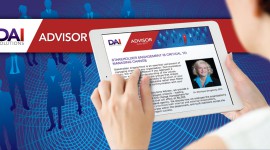12 Oct
2017
HOW TO COMMUNICATE EFFECTIVELY WHEN YOU CAN’T COMMUNICATE DIRECTLY
Bruce Hall
87
communications
,
DAI Solutions Advisor
,
Employee engagement
,
James Manthey
,
newsletter
,
program effectiveness
0 Comments
By James Manthey
All communicators want to have a direct line to push their messaging forward, but what happens when you can’t control the timing, vehicle, or even the message’s content? This is the issue we encountered while supporting a federal agency’s implementation of an enterprise-wide HR IT system. Though we worked with the offices of HR and IT at the agency level, we were restricted in how we could reach out to the functional organizations, which had a high degree of autonomy in their policy, communications, and human resources operations. This led to two major communications challenges:
 We could not control when stakeholders received our messaging since organizations had their own in-house communications shops. We could provide messaging to those communications teams, but couldn’t be sure when it would be delivered to stakeholders.
We could not control when stakeholders received our messaging since organizations had their own in-house communications shops. We could provide messaging to those communications teams, but couldn’t be sure when it would be delivered to stakeholders.- We could not be certain that the messaging we sent would be consistent and accurate across the agency since we had no control over what went out once we passed it over the fence.
We needed traction within each functional organization to overcome these issues. Our solution was to find “champions” and “change agents.” Champions are those who are the most excited about the message or project. They believe in the idea behind the project and genuinely want to help it succeed. Change agents are those who have the power to enact change. Change agents can be executives, managers, or informal leaders who hold sway within the organization. Change agents and champions can be one and the same, which is extremely helpful but uncommon.
In our case, we presented our project to the HR centers of the functional organizations. We could tell right away from the level of engagement during the presentations who could be our champions and who could be possible change agents. After each meeting, we reached out to those people to thank them for attending and establish relationships with them. We asked how they distributed information inside their organizations and what vehicles they had in place for communicating. We then invited them to participate in our newly established communications community of practice.
This community of practice brought together communicators and HR practitioners from across the agency to share information and discuss best practices. The community of practice idea was well received, and we had at least one person from each major functional organization attend our first gathering. At each successive meeting, we made sure that we provided timely information and asked the members to spread the word to anyone else who might be interested. From there, the number of change agents and champions grew as more and more people heard about what we were doing.
Through this communications community of practice, we created a strong core group of trusted, reliable members to whom we could pass crafted messages, knowing that those messages would go out in a timely manner with our intended meaning intact. None of this would have been possible if not for those first champions and change agents spreading the word and helping us build rapport with our audiences.





